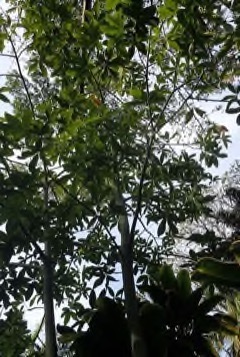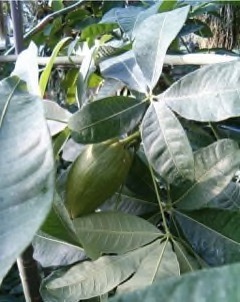 |
|
wikimedia.org / Krzysztof Ziarnek, Kenraiz |
 |
| wikimedia.org |
Translate this page:
Summary
Physical Characteristics

 Pachira glabra is an evergreen Tree growing to 15 m (49ft) by 15 m (49ft) at a fast rate.
Pachira glabra is an evergreen Tree growing to 15 m (49ft) by 15 m (49ft) at a fast rate.
See above for USDA hardiness. It is hardy to UK zone 10. The flowers are pollinated by Insects.
Suitable for: light (sandy), medium (loamy) and heavy (clay) soils. Suitable pH: mildly acid, neutral and basic (mildly alkaline) soils. It can grow in semi-shade (light woodland) or no shade. It prefers dry or moist soil and can tolerate drought.
UK Hardiness Map
US Hardiness Map
Synonyms
Bombacopsis glabra (Pasq.) A.Robyns Bombax glabrum (Pasq.) A.Robyns Bombax kimuenzae De Wild. & T.Durand Bombax oleagineum A.Robyns Pochota glabra (Pasq.) Bullock
Plant Habitats
Edible Uses
Edible Parts: Leaves Oil Seed
Edible Uses: Oil
Seed - raw or cooked[307 ]. The seeds can be boiled or roasted like chestnuts[307 , 419 ]. Rich in oil[332 ]. Similar to groundnuts in flavour[332 ]. The young leaves are said to be eaten[332 ]. Also, known as Pachira nut.
References More on Edible Uses
Medicinal Uses
Plants For A Future can not take any responsibility for any adverse effects from the use of plants. Always seek advice from a professional before using a plant medicinally.
None known
References More on Medicinal Uses
The Bookshop: Edible Plant Books
Our Latest books on Perennial Plants For Food Forests and Permaculture Gardens in paperback or digital formats.

Edible Tropical Plants
Food Forest Plants for Hotter Conditions: 250+ Plants For Tropical Food Forests & Permaculture Gardens.
More

Edible Temperate Plants
Plants for Your Food Forest: 500 Plants for Temperate Food Forests & Permaculture Gardens.
More

More Books
PFAF have eight books available in paperback and digital formats. Browse the shop for more information.
Shop Now
Other Uses
Containers Hedge Oil Wood
Agroforestry Uses: The plant is easily reproduced from cuttings and so is widely used as a hedge in coastal regions of Brazil[419 ]. It is sometimes grown to provide shade in cocoa plantations[419 ]. Other Uses: The wood is very light in weight, soft, with loose tissue and of low natural durability. It is sometimes used for making light objects such as boxes, rulers and toys[419 ].
Special Uses
Carbon Farming Food Forest Hedge
References More on Other Uses
Cultivation details
Staple Crop: Protein-oil
Prefers a deep, fertile loamy soil in full sun or light shade[200 , 307 ]. A fast-growing tree, it can reach a height of 3.5 metres within 2 years from seed[419 ]. It is very adaptable to different soil types, grows well in full sun or partial shade, and is resistant to both drought and flooding. Trees begin to fruit at about 4-5 years, a mature tree producing from 50-80 fruits per year.
Carbon Farming
-
Staple Crop: Protein-oil
(16+ percent protein, 16+ percent oil). Annuals include soybeans, peanuts, sunflower seeds. Perennials include seeds, beans, nuts, and fruits such as almond, Brazil nut, pistachio, walnut, hazel, and safou.
References Carbon Farming Information and Carbon Sequestration Information
Temperature Converter
Type a value in the Celsius field to convert the value to Fahrenheit:
Fahrenheit:
The PFAF Bookshop
Plants For A Future have a number of books available in paperback and digital form. Book titles include Edible Plants, Edible Perennials, Edible Trees,Edible Shrubs, Woodland Gardening, and Temperate Food Forest Plants. Our new book is Food Forest Plants For Hotter Conditions (Tropical and Sub-Tropical).
Shop Now
Plant Propagation
Seed - best sown as soon as it is ripe in a partially shaded position in individual containers. A germination rate of virtually 100% can be expected, with the seed sprouting within 5 - 10 days[419 ]. The seedlings develop quickly and should be ready to plant out 3 - 4 months later[419 ]. Cuttings root easily[419 ]. Layering
Other Names
If available other names are mentioned here
Pachira nut. Amendoim-de-arvore, American chestnut, Cacau-do-maranhao, Cacau-selvagem, Castanha-da-praia, Castanha-do-maranhao, Mamorana, Malabar Chestnut, Saba Nut, Provision Tree, Guiana Chestnut, Guyana Chestnut, Monguba, Munguba, Pumpo, Money Tree [1-4].
Native Range
SOUTHERN AMERICA: Brazil, Minas Gerais, Pernambuco, Rio de Janeiro,
Weed Potential
Right plant wrong place. We are currently updating this section.
Please note that a plant may be invasive in one area but may not in your area so it's worth checking.
None Known
Conservation Status
IUCN Red List of Threatened Plants Status : This taxon has not yet been assessed

Growth: S = slow M = medium F = fast. Soil: L = light (sandy) M = medium H = heavy (clay). pH: A = acid N = neutral B = basic (alkaline). Shade: F = full shade S = semi-shade N = no shade. Moisture: D = dry M = Moist We = wet Wa = water.
Now available:
Food Forest Plants for Mediterranean Conditions
350+ Perennial Plants For Mediterranean and Drier Food Forests and Permaculture Gardens.
[Paperback and eBook]
This is the third in Plants For A Future's series of plant guides for food forests tailored to
specific climate zones. Following volumes on temperate and tropical ecosystems, this book focuses
on species suited to Mediterranean conditions—regions with hot, dry summers and cool, wet winters,
often facing the added challenge of climate change.
Read More
Expert comment
Author
Pasq.
Botanical References
Links / References
For a list of references used on this page please go here
A special thanks to Ken Fern for some of the information used on this page.
Readers comment
| Add a comment |
|
If you have important information about this plant that may help other users please add a comment or link below. Only comments or links that are felt to be directly relevant to a plant will be included. If you think a comment/link or information contained on this page is inaccurate or misleading we would welcome your feedback at [email protected]. If you have questions about a plant please use the Forum on this website as we do not have the resources to answer questions ourselves.
* Please note: the comments by website users are not necessarily those held by PFAF and may give misleading or inaccurate information.
To leave a comment please Register or login here All comments need to be approved so will not appear immediately.
|
|